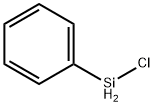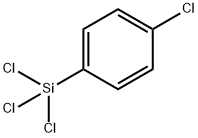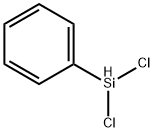(DICHLOROPHENYL)TRICHLOROSILANE
- CAS NO.:27137-85-5
- Empirical Formula: C6H3Cl5Si
- Molecular Weight: 280.44
- MDL number: MFCD00018078
- EINECS: 248-254-3
- SAFETY DATA SHEET (SDS)
- Update Date: 2024-03-14 15:18:31

What is (DICHLOROPHENYL)TRICHLOROSILANE?
Description
Dichlorophenyl trichloro-silane is a strawcolored liquid. Molecular weight=280.43; Boilingpoint=258.6℃; Vapor pressure=,1 mmHg at 18℃;Flash point=141℃. Hazard Identification (based onNFPA-704 M Rating System): Health 3, Flammability 1,Reactivity 2. Decomposes in water.
Chemical properties
Dichlorophenyl trichlorosilane is a strawcolored liquid.
General Description
(DICHLOROPHENYL)TRICHLOROSILANE is a straw colored liquid with a pungent odor. Material will burn though (DICHLOROPHENYL)TRICHLOROSILANE may require some effort to ignite. (DICHLOROPHENYL)TRICHLOROSILANE is decomposed by moisture or water to hydrochloric acid with evolution of heat. (DICHLOROPHENYL)TRICHLOROSILANE is corrosive to metals and tissue. (DICHLOROPHENYL)TRICHLOROSILANE is used as an intermediate for silicones.
Reactivity Profile
Chlorosilanes, such as (DICHLOROPHENYL)TRICHLOROSILANE, are compounds in which silicon is bonded to from one to four chlorine atoms with other bonds to hydrogen and/or alkyl groups. Chlorosilanes react with water, moist air, or steam to produce heat and toxic, corrosive fumes of hydrogen chloride. They may also produce flammable gaseous H2. They can serve as chlorination agents. Chlorosilanes react vigorously with both organic and inorganic acids and with bases to generate toxic or flammable gases.
Health Hazard
Contact causes burns to skin and eyes. If inhaled, it may be harmful. Fire may produce irritating or poisonous gases. The compound is highly toxic by inhalation and is a strong irritant to the skin and eyes.
Fire Hazard
(DICHLOROPHENYL)TRICHLOROSILANE may burn but does not ignite readily. Flammable/poisonous gases may accumulate in tanks and hopper cars. (DICHLOROPHENYL)TRICHLOROSILANE may ignite combustibles (wood, paper, oil, etc.). The compound is a slight fire hazard when exposed to heat or flame. (DICHLOROPHENYL)TRICHLOROSILANE is decomposed by moisture or water to hydrochloric acid with the evolution of heat.
Safety Profile
Poison by ingestion, inhalation, subcutaneous, and intraperitoneal routes. Corrosive to the eyes, skin, and mucous membranes. On contact with moisture it releases corrosive HCl. Combustible when exposed to heat or flame. When heated to decomposition it emits toxic fumes of Cl-. See also CHLOROSILANES.
Potential Exposure
This material is used in silicone polymer manufacture.
First aid
If this chemical gets into the eyes, remove anycontact lenses at once and irrigate immediately for at least15 min, occasionally lifting upper and lower lids. Seek medical attention immediately. If this chemical contacts theskin, remove contaminated clothing and wash immediatelywith soap and water. Seek medical attention immediately. Ifthis chemical has been inhaled, remove from exposure,begin rescue breathing (using universal precautions, including resuscitation mask) if breathing has stopped and CPR ifheart action has stopped. Transfer promptly to a medicalfacility. When this chemical has been swallowed, get medical attention. If victim is conscious, administer water ormilk. Do not induce vomiting. Medical observation isrecommended for 24-48 h after breathing overexposure, aspulmonary edema may be delayed. As first aid for pulmonary edema, a doctor or authorized paramedic may consideradministering a corticosteroid spray.
storage
(1) Color Code—White: Corrosive or ContactHazard; Store separately in a corrosion-resistant location.(2) Color Code—Blue: Health Hazard/Poison: Store in asecure poison location. Prior to working with this chemicalyou should be trained on its proper handling and storage.Dichlorophenyl trichloro-silane should be stored to avoidcontact with moisture or with combustible materials, suchas wood, paper, and oil.
Shipping
UN2987 Chlorosilanes, corrosive, n.o.s, Hazard class: 8; Labels: 8-Corrosive material.
Incompatibilities
Incompatible with oxidizers (chlorates, nitrates, peroxides, permanganates, perchlorates, chlorine, bromine, fluorine, etc.); contact may cause fires or explosions. Keep away from alkaline materials, strong bases, strong acids, oxoacids, and epoxides. Chlorosilanes react vigorously with bases and both organic and inorganic acids generating toxic and/or flammable gases. Chlorosilanes react with water, moist air, or steam to produce heat and toxic, corrosive fumes of hydrogen chloride. They may also produce flammable gaseous hydrogen. Contact with ammonia may form a self-igniting material. Attacks some metals in the presence of moisture
Properties of (DICHLOROPHENYL)TRICHLOROSILANE
| Boiling point: | 260 °C |
| Density | 1.553 |
| refractive index | 1.5640 |
| Flash point: | 150°C |
| Specific Gravity | 1.553 |
| Hydrolytic Sensitivity | 8: reacts rapidly with moisture, water, protic solvents |
| EPA Substance Registry System | Trichloro(dichlorophenyl)silane (27137-85-5) |
Safety information for (DICHLOROPHENYL)TRICHLOROSILANE
Computed Descriptors for (DICHLOROPHENYL)TRICHLOROSILANE
New Products
4-(Dimethylamino)tetrahydro-2H-pyran-4-carbonitrile 4-AMINO-TETRAHYDRO-PYRAN-4-CARBOXYLIC ACID 4-Aminotetrahydropyran-4-carbonitrile Hydrochloride (R)-3-Aminobutanenitrile Hydrochloride 4-AMINO-TETRAHYDRO-PYRAN-4-CARBOXYLIC ACID HCL 3-((Dimethylamino)methyl)-5-methylhexan-2-one oxalate 5-Bromo-2-nitropyridine Nimesulide BP Aceclofenac IP/BP/EP Diclofenac Sodium IP/BP/EP/USP Mefenamic Acid IP/BP/EP/USP Ornidazole IP Diclofenac Potassium SODIUM AAS SOLUTION ZINC AAS SOLUTION BUFFER SOLUTION PH 10.0(BORATE) GOOCH CRUCIBLE SINTERED AQUANIL 5 BERYLLIUM AAS SOLUTION Methylcobalamin (vitamin B12) SODIUM METHYL PARABEN SODIUM VALPROATE AMOXICILLIN (AMOXYCILLIN) TRIHYDRATE ACICLOVIRRelated products of tetrahydrofuran








You may like
-
 1-Methyl-6-oxo-1,6-dihydropyridazine-3-carbonitrile 98%View Details
1-Methyl-6-oxo-1,6-dihydropyridazine-3-carbonitrile 98%View Details
99903-60-3 -
 88491-46-7 98%View Details
88491-46-7 98%View Details
88491-46-7 -
 1823368-42-8 98%View Details
1823368-42-8 98%View Details
1823368-42-8 -
 2-(3-(tert-butyl)phenoxy)-2-methylpropanoic acid 1307449-08-6 98%View Details
2-(3-(tert-butyl)phenoxy)-2-methylpropanoic acid 1307449-08-6 98%View Details
1307449-08-6 -
 Ethyl 3-(furan-2-yl)-3-hydroxypropanoate 25408-95-1 98%View Details
Ethyl 3-(furan-2-yl)-3-hydroxypropanoate 25408-95-1 98%View Details
25408-95-1 -
 2-Chloro-5-fluoro-1-methoxy-3-methylbenzene 98%View Details
2-Chloro-5-fluoro-1-methoxy-3-methylbenzene 98%View Details
1805639-70-6 -
 1784294-80-9 98%View Details
1784294-80-9 98%View Details
1784294-80-9 -
 Lithium ClavulanateView Details
Lithium ClavulanateView Details
61177-44-4